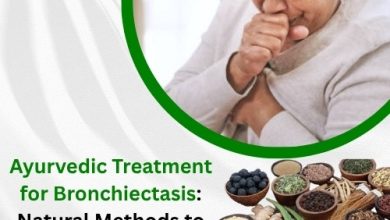Promising New Treatments for Bronchiectasis: What You Should Know

Introduction: A Changing Approach to Bronchiectasis Care
If you’re living with bronchiectasis, you’ve likely spent years managing persistent cough, thick sputum, and repeated infections. Until recently, treatment focused on long-term antibiotics, airway clearance, and managing exacerbations. However, recent medical research has led to new treatments for bronchiectasis that offer more targeted and effective options.
The latest advancements you should know about—including therapies under trial, those recently approved in the UK, and innovations in physiotherapy and device-based treatment.
Understanding Bronchiectasis Before Exploring New Options
Bronchiectasis causes irreversible widening of the airways, trapping mucus and creating an ideal environment for infections. Over time, this leads to lung damage, fatigue, shortness of breath, and reduced quality of life. It affects both adults and children, and many live with the condition for years before receiving a correct diagnosis.
Traditional management usually includes:
- Long-term antibiotics (oral, nebulised or IV)
- Chest physiotherapy
- Mucolytics
- Bronchodilators
- Anti-inflammatory strategies
- Vaccinations and infection prevention
But as the disease varies greatly in severity and progression, there’s an urgent need for new bronchiectasis treatment approaches that are more precise and patient-specific.

Related Article: What is Bronchiectasis, and How is It Treated?
- Inhaled Antibiotics: A Targeted Shift in Therapy
One of the most significant advancements is the development of new inhaled antibiotics. Instead of taking high-dose oral antibiotics, patients now have options that go straight into the lungs.
Recent Innovations:
- Liposome-encapsulated ciprofloxacin (Lipoquin/Apulmiq): This formulation stays longer in the lungs and delivers higher concentrations with fewer systemic side effects.
- Colistimethate sodium (Colobreathe): Though used primarily in cystic fibrosis, it’s being trialled in patients with bronchiectasis in the UK.
- Tobramycin (TOBI): Inhaled tobramycin is being tested for non-CF bronchiectasis, especially in cases with Pseudomonas aeruginosa colonisation.
These treatments have shown improvement in lung function and a reduction in exacerbation frequency. If you’re asking are there any new treatments for bronchiectasis, this is one of the most promising categories.
- Biologic Therapies: Targeting Inflammation More Precisely
Biologic drugs are commonly associated with asthma and autoimmune conditions. But researchers are now studying their role in bronchiectasis, particularly in people with overlapping eosinophilic inflammation or allergic bronchopulmonary aspergillosis (ABPA).
Current Focus:
- Mepolizumab: Targets IL-5, helping reduce inflammation in eosinophilic-dominant cases.
- Dupilumab: Has shown effectiveness in conditions with overlapping asthma and nasal polyps, which also occur in bronchiectasis patients.
- Omalizumab: Used in ABPA and being tested for broader use in non-CF bronchiectasis.
Biologic therapies may not replace antibiotics, but they add a layer of personalised control for patients with more inflammatory presentations.
Related Article: Natural Treatments for Bronchiectasis That Can Support Your Breathing and Wellbeing
- CFTR Modulators for Selected Patients
Although designed for cystic fibrosis, CFTR modulators such as ivacaftor are being tested in a small subset of bronchiectasis patients who carry CFTR gene mutations without a full CF diagnosis.
These drugs help restore chloride transport in the airway epithelium, improving mucus clearance. While still experimental, it represents an important step in precision therapy.
- Macrolide Therapy: Evolving Uses and Considerations
Macrolides such as azithromycin and erythromycin are already used for their anti-inflammatory and immunomodulatory effects. Recent studies have refined the way they’re prescribed.
Updated Practice:
- Long-term azithromycin (250mg three times weekly) is now common in patients with more than two exacerbations per year.
- Regular ECG monitoring is advised due to potential cardiac side effects.
- Concerns about antibiotic resistance are pushing researchers to develop alternatives.
Though not entirely new, updated prescribing strategies help improve safety and effectiveness, particularly within new treatments for bronchiectasis UK clinical guidelines.
Related Article: Is Bronchiectasis Cough Treatment Different from Regular Cough Treatment?
- Phage Therapy: A Revival of a Forgotten Concept
Phage therapy uses viruses that specifically infect bacteria. This has gained renewed interest due to rising antibiotic resistance in bronchiectasis.
Current Research:
- Phage therapy for Pseudomonas aeruginosa is undergoing trials in Europe and the UK.
- Tailored phage cocktails can be developed based on an individual’s bacterial cultures.
- Delivery via nebulisation is under review.
This approach remains experimental but shows promise, especially for those with resistant infections.
- Smart Airway Clearance Devices
Airway clearance remains a cornerstone of treatment. However, modern devices have made it more efficient and user-friendly.
Examples:
- Oscillatory PEP devices (e.g., Aerobika, Acapella): Combine vibration and positive pressure to loosen mucus.
- Smart vest therapy: High-frequency chest wall oscillation (HFCWO) improves mucus clearance in severe cases.
- App-linked devices: Some newer models record usage and sync with mobile apps, helping patients and clinicians track compliance.
These devices support daily management and are increasingly prescribed alongside new bronchiectasis treatment plans in specialist clinics.
Related Article: Herbal Treatment for Bronchiectasis: Herbs That Can Improve Lung Function
- Mucolytic Therapies: Going Beyond Carbocisteine
Traditional mucolytics like carbocisteine are still used, but newer options are being explored.
What’s New:
- Inhaled mannitol: Draws water into the airways, thinning mucus. Trials show improved sputum clearance and lung function.
- Hypertonic saline: Widely used in CF, now recommended in selected bronchiectasis cases.
- Recombinant human DNase (dornase alfa): Under evaluation despite mixed results in non-CF patients.
These treatments aren’t appropriate for everyone, but they expand the options for those with thick, sticky mucus that’s difficult to clear.
- Anti-inflammatory Research: Beyond Steroids
Oral and inhaled steroids have a limited role in bronchiectasis. Current trials are exploring alternative options.
Under Investigation:
- Brensocatib: An oral inhibitor of neutrophil serine proteases. Phase 2 trials showed reduced exacerbations and improved quality of life.
- Roflumilast: Already used in COPD, it’s being considered for overlap syndromes.
These drugs may soon change how we manage inflammation, providing an alternative to long-term steroid use.
- Nutritional and Lifestyle Support
While not a substitute for medical treatment, nutrition and daily routines play a crucial part. Many UK clinics now offer:
- Specialist dietitian support
- Pulmonary rehabilitation programmes
- Smoking cessation assistance
- Mental health referrals for chronic illness support
These approaches strengthen the core treatment plan, and many clinics now integrate them into their new treatments for bronchiectasis UK protocols.
Related Article: Bronchiectasis Relief can be found in Natural Treatment
- Clinical Trials: Opportunities for UK Patients
Many patients in the UK can access emerging treatments by enrolling in clinical trials. NHS sites such as NIHR (National Institute for Health and Care Research) and platforms like ISRCTN Registry list active studies.
You can also speak with your respiratory consultant to see if you’re eligible for studies involving:
- Novel antibiotics
- Anti-inflammatory drugs
- Phage therapy
- Device innovations
If you’re researching bronchiectasis new treatment, clinical trial participation could give you early access to promising therapies.
Final Thoughts
Managing bronchiectasis no longer means relying solely on outdated options. From inhaled antibiotics to smart devices and cutting-edge biologics, new treatments for bronchiectasis are offering more hope than ever before.
Whether you’re newly diagnosed or have lived with the condition for years, it’s worth discussing these developments with your respiratory team. Some therapies may already be available through NHS specialist centres, especially if you’re based in the UK.
If you’d like to explore another article focused on complementary care strategies, see our full feature on new bronchiectasis treatment and lifestyle support.




